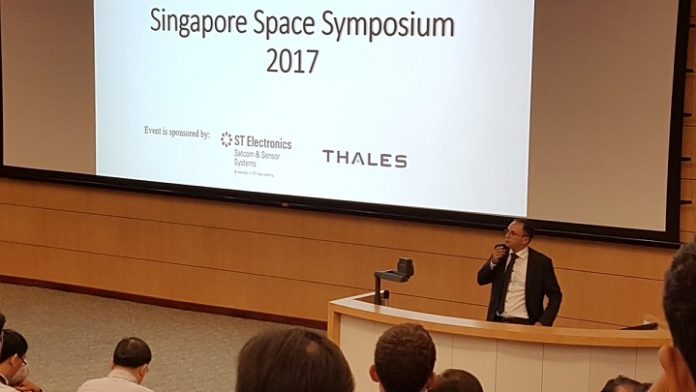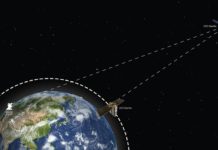The Singapore Space Symposium, held at the National University of Singapore (NUS) on 27 September 2017, saw presentations by Thales Alenia and Airbus on the future of small satellites.
During the symposium, Luca Simonini, S4TIN Co-Director, Thales Alenia Space, spoke on the topic Small Sats, from Research Tool to Infrastructure for Services. Following this, Laurent Jaffart, Vice President, Head of Future Programmes, Airbus Defence and Space, spoke about the future of both traditional geostationary satellites and small satellite constellations in a presentation titled Small Satellite Constellation Technology and Industrial Revolution.
Commercial small satellites
Both Simonini and Jaffart stated that small satellites are now a reality in the commercial space, partly because of the ability to form constellations.
“Ten years ago, large constellations of small satellites were more a dream for some actors. It was even a sweet and sour dream. Today it is a reality.” – laurent Jaffart
Simonini commented on the use of small satellite constellations for Earth Observation (EO), saying, “Now, companies are also entering this play into small satellites, because they use constellations to make operational services. Earth imaging grows because of huge constellations launched in the past few years, like the Planet constellation, as well as weather forecasting, with Spire.”
According to Jaffart, however, small satellites are not a new thing, and, contrary to popular opinion, the trend has been for satellites to get larger instead of smaller.
He said, “Since decades, the average mass of satellites has increased. When we look at the past, the first satellites were in the area of 100kg, with an average of about 3 tonnes today. The operators are looking for more bandwidth when it’s a question of telecommunication, as well as more power, more robustness, and more performance on instruments and payloads”.
The attraction of small satellites
Both speakers mentioned that small satellites, in particular CubeSats, are popular because of their low cost and replaceability. This not only enables new entrants into the satellite market, but also significantly lowers the risk of a mission.
According to Simonini, one reason why small satellites are less expensive is the ability to use commercial components.
He said, “If you remain in Low Earth Orbit (LEO), you can use commercial components because failures start with high altitude. If you remain in LEO you can reliably use commercial components, available and designed for use in ground operations With the bigger satellites, you’d better go with radiation-hardened components.”
Also, he said, launch costs are significantly lowered because of their size, “If you want to bring a big satellite, then you have to wait a long time before you get a ride to space. But all these rockets have small, limited places available for secondary payloads, for a limited amount of money, in a very short time.”.
The ability to easily replace satellites is also a major draw; according to Simonini, this enables operators to adopt a “fly – learn – refly” approach that is impossible for larger satellites.
“Big satellites are not conceived to be replaceable or repairable. You cannot maintain satellites to live for a long time in orbit because you don’t have possibilities to change parts”.
“[Cubesats] use a fly-learn-refly approach, so you reduce the test campaign. If they fail, it’s not a major issue. You learn and you refly, producing the corrective action”. – Luca Simonini
Referring to the same topic, Jaffart said that this offers the possibility of risk distribution. “[Small satellites] are less expensive, easier to upgrade, easier to update over time, and allow for disaggregation of the risk compared to the larger spacecraft. If you only launch one, you better have one that will work. When you are launching several dozens or hundreds, you can afford to have some losses”.
Although most of the benefits of small satellite constellations lie in their cost and convenience, Jaffart pointed out that they do have some technological advantages over the larger satellites, such as their proximity to the ground for telecommunications purposes.
He said, “The benefit of a constellation of smaller satellites in the telecommunications area is that they’re flying much closer to the earth and solve part of the problem of the latency that you have when you’re trying to reach a geostationary satellite 36,000km away from the earth.”
Challenges of small satellites
Both Simonini and Jaffart touched upon the challenges of using small satellites, comparing them to larger satellites in terms of their payload capabilities.
Simonini described how CubeSats do not have enough power to offer credible commercial services, saying, “If you take a 1U CubeSat, you have basically have 12W that can be installed. But when it operates in orbit, it receives a maximum of 4W. This is a huge limitation – If you take just our light bulb, it consumes much more. And even bigger satellites have limited power availability for the payload. That’s why there are extensions – deployable mechanisms like deployable solar arrays, in order to capture as much power as possible”.
He also mentioned the difficulty of achieving pointing accuracy for EO purposes, saying, “Another challenge…is pointing accuracy, which is very stringent especially for optical observation study, which relates to EO. Also, the mechanical stability [for such purposes].”
Jaffart explained that small satellites, even in constellations, cannot capture high resolution images as needed in sectors such as government and military.
He said, “The small satellites do offer sufficient capabilities for some applications like agriculture or the logistics industry. For these industries, lower resolution may be sufficient. On the other hand, for the intelligence community, it is the exceptional need for exquisite resolutions that have driven the need for larger satellites”.
Simonini and Jaffart also highlighted the inability to control the orbit of a small satellite, especially a CubeSat, as a major problem. Jaffart pointed out that this is especially worrying when a Cubesat reaches the end of its life.
Said Jaffart, “The problem with CubeSats, and when I see those graphs with CubeSats being launched by the hundreds every year, is those Cubesats are not managed, not controlled, and could create issues to access space in case of collisions”.
Do small satellite constellations really cost less?
Although individual small satellites cost less than a large satellite, Jaffart expressed that small satellite constellations require a huge capital expenditure, especially for telecommunications purposes.
He explained, “When we look at the geostationary telecommunications satellites, you still have the best ratio of price per transponder, so there is an interesting complementarity between the large geostationary satellites and the small satellite constellation”.
He added that building a constellation for telecommunications services necessitates global coverage, saying, “In telecommunications, unlike for imagery, you cannot have any gap in the coverage. So basically the barrier to entry is, to start a service, you need to have a full coverage of the globe. And that’s quite a capital expenditure that companies sometimes struggle to raise. You also have to plan for a quick market entry because [a satellite operator] will only be able to start revenues once he has a complete coverage of the globe.”
Another issue, raised by both Jaffart and Simonini, is the cost of launching so many satellites.
Jaffart cited the example of OneWeb. “The access to space remains the key problem, and the amount of money to launch constellations remains also one of the highest barriers to entry for telecom operators. In the case of OneWeb, they have procured 21 Soyuz to be able to launch their constellation. This is more expensive than the satellites themselves”.
Simonini described how satellite failures can add to increased launch costs, adding that ensuring quality and reliability of each satellite is very important.
“Launch costs dramatically increase if you have low quality satellites”. – luca simonini
“If you think about a 100-satellite constellation, you will have 150 satellites to launch in 5 years if quality is ensured. Otherwise, you need more or less 400 satellites in 5 years. This is a very high cost,” he elaborated
What is needed
Simonini pointed out that, in order to ensure sustainable commercial services using small satellites, quality control and process standardization are needed.
He said, “What we see is, as the quality processes for the producer of these satellites increases, the higher the success rates. If you compare industrial production of smallsats by big satellite producers, which apply high quality and standard processes, we see that more than 80% of the satellites have achieved their objectives. Whereas with the small startups or universities who apply some quality and processes…less than 50% achieve their mission. For hobbyists, it’s even lower”.
For Jaffart, achieving successful small satellite constellations means having to rethink the design and manufacturing of satellites.
He said, “The smallsat constellations benefit from an economies of scale. You have to approach the design of the satellite in a different way. You have to approach the design to manufacture”.
“When you look at large geostationary telecom satellites, these are satellites which are done like haute couture. In a large constellation, you are more in the repeat model of the product, and you have to design your satellite to be manufactured efficiently”. – laurent Jaffart
He also explained that small satellite constellations will cater to different customers compared to large satellites.
“We do believe we will start to see the emergence a free space for commercial actors to create commercial services with high value-add and a much larger customer base. But the business model has to adjust. The commercial customers will buy a service, an imagery solution. You have to look at an end-to-end service where we will see the prevalence of image processing and image interpretation. At this level, software solutions, change detection, raw data analysis, and big data make and enable the differentiation between the different firms selling commercial images”.
The future of satellites
Jaffart proposed that the future will see a complementarity between small satellites and the larger traditional satellites, drawing an analogy with computers.
He described, “When we take the computer analogy, at the beginning the computers were mainframes. And those mainframes have become dissimilated into personal computers. But to this day, those mainframes or supercomputers are still existing and still playing an essential role, in particular in the analysis of scientific issues or cryptographic problems. Personal computers give incredible capabilities to individuals, at an affordable price, but basically what we see is the two co-exist and complement each other”.
He concluded, “I think that is what is going to happen, and what is happening, in the space world. The revolution of the small satellites offer disruption in the value chain and allow us to address a paradigm such as mass manufacturing, new business models, and to address a domain which was, until now, fenced up. NewSpace is in fact just an acceleration of innovation. We see a complementarity between all the different actors.”







